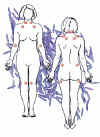|
What Is Fibromyalgia?
 Fibromyalgia
is a chronic disorder characterized by widespread
musculoskeletal pain, fatigue, and multiple tender points.
"Tender points" refers to tenderness that occurs in precise,
localized areas, particularly in the neck, spine, shoulders,
and hips. People with this syndrome may also experience
sleep disturbances, morning stiffness, irritable bowel
syndrome, anxiety, and other symptoms. Fibromyalgia
is a chronic disorder characterized by widespread
musculoskeletal pain, fatigue, and multiple tender points.
"Tender points" refers to tenderness that occurs in precise,
localized areas, particularly in the neck, spine, shoulders,
and hips. People with this syndrome may also experience
sleep disturbances, morning stiffness, irritable bowel
syndrome, anxiety, and other symptoms.
How
Many People Have Fibromyalgia?
According to the American
College of Rheumatology, fibromyalgia affects 3 to 6 million
Americans. It primarily occurs in women of childbearing age,
but children, the elderly, and men can also be affected.
What
Causes Fibromyalgia?
 Although
the cause of fibromyalgia is unknown, researchers have
several theories about causes or triggers of the disorder.
Some scientists believe that the syndrome may be caused by
an injury or trauma. This injury may affect the central
nervous system. Fibromyalgia may be associated with changes
in muscle metabolism, such as decreased blood flow, causing
fatigue and decreased strength. Others believe the syndrome
may be triggered by an infectious agent such as a virus in
susceptible people, but no such agent has been identified. Although
the cause of fibromyalgia is unknown, researchers have
several theories about causes or triggers of the disorder.
Some scientists believe that the syndrome may be caused by
an injury or trauma. This injury may affect the central
nervous system. Fibromyalgia may be associated with changes
in muscle metabolism, such as decreased blood flow, causing
fatigue and decreased strength. Others believe the syndrome
may be triggered by an infectious agent such as a virus in
susceptible people, but no such agent has been identified.
How
Is Fibromyalgia Diagnosed?
Fibromyalgia
is difficult to diagnose because many of the symptoms mimic
those of other disorders. The physician reviews the
patient's medical history and makes a diagnosis of
fibromyalgia based on a history of chronic widespread pain
that persists for more than 3 months. The American College
of Rheumatology (ACR) has developed criteria for
fibromyalgia that physicians can use in diagnosing the
disorder. According to ACR criteria, a person is considered
to have fibromyalgia if he or she has widespread pain in
combination with tenderness in at least 11 of 18 specific
tender point sites.
How
Is Fibromyalgia Treated?
 Treatment
of fibromyalgia requires a comprehensive approach. The
physician, physical therapist, and patient may all play an
active role in the management of fibromyalgia. Studies have
shown that aerobic exercise, such as swimming and walking,
improves muscle fitness and reduces muscle pain and
tenderness. Heat and massage may also give short-term
relief. Antidepressant medications may help elevate mood,
improve quality of sleep, and relax muscles. Patients with
fibromyalgia may benefit from a combination of exercise,
medication, physical therapy, and relaxation. Treatment
of fibromyalgia requires a comprehensive approach. The
physician, physical therapist, and patient may all play an
active role in the management of fibromyalgia. Studies have
shown that aerobic exercise, such as swimming and walking,
improves muscle fitness and reduces muscle pain and
tenderness. Heat and massage may also give short-term
relief. Antidepressant medications may help elevate mood,
improve quality of sleep, and relax muscles. Patients with
fibromyalgia may benefit from a combination of exercise,
medication, physical therapy, and relaxation.
What Is The
Herb Maca?
|
 Maca
is a hearty root vegetable plant which grows in
the high Andean plateaus of Peru at altitudes as
high as 14,500 feet above sea level. Little is
known about the origins of MACA, but the plant
is believed to have been cultivated in the Junin
Plateau region of the Central Highlands in an
area called Cerro de Pasco as far back as 2,000
years ago. The herb is becoming widely used for
fibromyalgia, since it eliminates fatigue and
several other associated symptoms. The Inca's of
Peru were sophisticated builders and cultivators
of the land and may have been responsible for
the cultivation of MACA which have been found in
archaeological sites. Many legends exist about
the nourishing powers of MACA, such as it's
ability to promote sexual desire and increased
energy and stamina. The only area where this
particular species of MACA is found is a region
of extreme weather conditions such as freezing,
high winds, and intensive sunlight. No other
food plant exists in the world which will grow
at so high an altitude and survive.
Maca Continued Here
Order Maca Here Maca
is a hearty root vegetable plant which grows in
the high Andean plateaus of Peru at altitudes as
high as 14,500 feet above sea level. Little is
known about the origins of MACA, but the plant
is believed to have been cultivated in the Junin
Plateau region of the Central Highlands in an
area called Cerro de Pasco as far back as 2,000
years ago. The herb is becoming widely used for
fibromyalgia, since it eliminates fatigue and
several other associated symptoms. The Inca's of
Peru were sophisticated builders and cultivators
of the land and may have been responsible for
the cultivation of MACA which have been found in
archaeological sites. Many legends exist about
the nourishing powers of MACA, such as it's
ability to promote sexual desire and increased
energy and stamina. The only area where this
particular species of MACA is found is a region
of extreme weather conditions such as freezing,
high winds, and intensive sunlight. No other
food plant exists in the world which will grow
at so high an altitude and survive.
Maca Continued Here
Order Maca Here |
What
Research Is Being Conducted on Fibromyalgia?
 The
NIAMS is sponsoring research that will increase
understanding of the specific abnormalities that cause and
accompany fibromyalgia with the hope of developing better
ways to diagnose, treat, and prevent this disorder. The
NIAMS is sponsoring research that will increase
understanding of the specific abnormalities that cause and
accompany fibromyalgia with the hope of developing better
ways to diagnose, treat, and prevent this disorder.
Recent NIAMS
studies show that abnormally low levels of the hormone
cortisol may be associated with fibromyalgia. At Brigham and
Women's Hospital in Boston, Massachusetts, and at the
University of Michigan Medical Center in Ann Arbor,
researchers are studying regulation of the function of the
adrenal gland (which makes cortisol) in fibromyalgia. People
whose bodies make inadequate amounts of cortisol experience
many of the same symptoms as people with fibromyalgia. It is
hoped that these studies will increase understanding about
fibromyalgia and may suggest new ways to treat the disorder.
NIAMS research studies are
looking at different aspects of the disorder. At the
University of Alabama in Birmingham, researchers are
concentrating on how specific brain structures are involved
in the painful symptoms of fibromyalgia. At George
Washington University in Washington, DC, scientists are
investigating the causes of a post-Lyme disease syndrome as
a model for fibromyalgia. Some patients develop a
fibromyalgia-like condition following Lyme disease, an
infectious disorder associated with arthritis and other
symptoms.
NIAMS-supported research on
fibromyalgia also includes several projects at the
Institute's Multipurpose Arthritis and Musculoskeletal
Diseases Centers. Researchers at these centers are studying
individuals who do not seek medical care, but who meet the
criteria for fibromyalgia. (Potential subjects are located
through advertisements in local newspapers asking for
volunteers with widespread pain or aching.) Other studies at
the Centers are attempting to uncover better ways to manage
the pain associated with the disorder through behavioral
interventions such as relaxation training.
In March 1998, NIAMS and
several other NIH institutes and offices issued a Request
for Proposals to promote research studies of fibromyalgia.
As a result of this request, NIAMS and its partners recently
funded 15 new fibromyalgia projects totaling more than $3.6
million.
The NIAMS
supports and encourages outstanding basic and clinical
research that increases the understanding of fibromyalgia.
However, much more research needs to be done before
fibromyalgia can be successfully treated or prevented.
The Federal
Government, in collaboration with researchers, physicians,
and private voluntary health organizations, is committed to
research efforts that are directed at significantly
improving the health of all Americans afflicted with
fibromyalgia. |






 Fibromyalgia
is a chronic disorder characterized by widespread
musculoskeletal pain, fatigue, and multiple tender points.
"Tender points" refers to tenderness that occurs in precise,
localized areas, particularly in the neck, spine, shoulders,
and hips. People with this syndrome may also experience
sleep disturbances, morning stiffness, irritable bowel
syndrome, anxiety, and other symptoms.
Fibromyalgia
is a chronic disorder characterized by widespread
musculoskeletal pain, fatigue, and multiple tender points.
"Tender points" refers to tenderness that occurs in precise,
localized areas, particularly in the neck, spine, shoulders,
and hips. People with this syndrome may also experience
sleep disturbances, morning stiffness, irritable bowel
syndrome, anxiety, and other symptoms. Although
the cause of fibromyalgia is unknown, researchers have
several theories about causes or triggers of the disorder.
Some scientists believe that the syndrome may be caused by
an injury or trauma. This injury may affect the central
nervous system. Fibromyalgia may be associated with changes
in muscle metabolism, such as decreased blood flow, causing
fatigue and decreased strength. Others believe the syndrome
may be triggered by an infectious agent such as a virus in
susceptible people, but no such agent has been identified.
Although
the cause of fibromyalgia is unknown, researchers have
several theories about causes or triggers of the disorder.
Some scientists believe that the syndrome may be caused by
an injury or trauma. This injury may affect the central
nervous system. Fibromyalgia may be associated with changes
in muscle metabolism, such as decreased blood flow, causing
fatigue and decreased strength. Others believe the syndrome
may be triggered by an infectious agent such as a virus in
susceptible people, but no such agent has been identified. Treatment
of fibromyalgia requires a comprehensive approach. The
physician, physical therapist, and patient may all play an
active role in the management of fibromyalgia. Studies have
shown that aerobic exercise, such as swimming and walking,
improves muscle fitness and reduces muscle pain and
tenderness. Heat and massage may also give short-term
relief. Antidepressant medications may help elevate mood,
improve quality of sleep, and relax muscles. Patients with
fibromyalgia may benefit from a combination of exercise,
medication, physical therapy, and relaxation.
Treatment
of fibromyalgia requires a comprehensive approach. The
physician, physical therapist, and patient may all play an
active role in the management of fibromyalgia. Studies have
shown that aerobic exercise, such as swimming and walking,
improves muscle fitness and reduces muscle pain and
tenderness. Heat and massage may also give short-term
relief. Antidepressant medications may help elevate mood,
improve quality of sleep, and relax muscles. Patients with
fibromyalgia may benefit from a combination of exercise,
medication, physical therapy, and relaxation. The
NIAMS is sponsoring research that will increase
understanding of the specific abnormalities that cause and
accompany fibromyalgia with the hope of developing better
ways to diagnose, treat, and prevent this disorder.
The
NIAMS is sponsoring research that will increase
understanding of the specific abnormalities that cause and
accompany fibromyalgia with the hope of developing better
ways to diagnose, treat, and prevent this disorder.